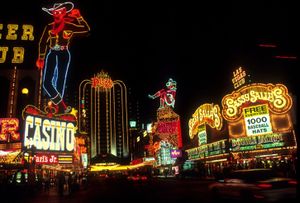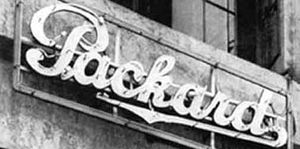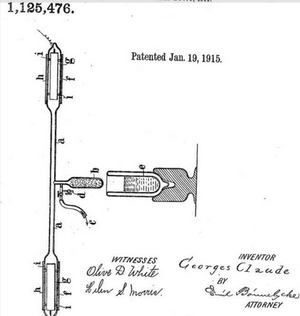Georges Claude
- Birthdate
- 1870
- Birthplace
- Paris, France
- Death date
- 1960/05/24
- Fields of study
- Lighting
Biography
This article was initially published in Today's Engineer on November 2014
“They say the neon lights are bright on Broadway”. So sang the Drifters in their hit “On Broadway”. These lyrics resonate with the idea that neon lights are deeply embedded in America culture.
The first neon lights in America made their appearance in 1923 at a Packard Car dealership in Los Angeles. The company paid $2,500 for two neon signs.[1] Each sign spelled out “Packard” in the typeface that came to define the company brand. Even for the exuberance and excess of the Roaring 20s, this was a lot of money. But the signs did manage to draw a lot of attention. Spellbound, crowds gathered and stared at these signs which were likened to “liquid fire”. Neon signs in the U.S., however, remained a rare sight until the end of Prohibition when their use exploded.
By the 1950s, as Rudi Stern wrote in his book Let There be Neon, “neon had become inextricably linked with drive-ins, diners, the glamour of Las Vegas and by extension, the American dream itself.” But it was the French electrical engineer, Georges Claude, who brought neon lighting to America. Not only was it his company that made the lights for Packard, but it was Georges Claude who, almost a century ago in in January 1915, received the patent for the neon light,
Georges Claude was born in Paris in 1870. Entering the École Supérieure de Chimie Industrielles de la Ville de Paris (today known as the Ecole Supérieure de Physique et de Chimie Industrielles de la Ville de Paris in 1886, at the age of 16, he graduated, in 1889, with a degree in electrical engineering. During the 1890s he worked for the Thomas-Houston Company. Claude had a flair for popularizing the emerging areas of electrical science and engineering. At the age of 24, he already saw the need “to make the study of electricity as pleasant as possible. …To bring an attractive science within the range of comprehension of ordinary people.” His 1901 book, L’Electricité à Ia portée de tout le monde was very popular. More than 60,000 copies were sold. While he worked at electrical technology during the day, in his spare time he was drawn into chemistry and chemical engineering.
In 1895, the chemist Le Chatelier had discovered that mixing oxygen and acetylene produced a flame hotter than any other known at the time. Le Chatelier wanted to commercialize the production of acetylene but ran into the nasty problem of the gas’s unpredictable explosiveness when stored. George Claude was then drawn in to help solve the problem. He found a way to stabilize the acetylene. But then Le Chatelier and his business associates soon discovered that without the ability to produce large quantities of oxygen cheaply, the oxyacetylene torch had little commercial potential. If one could liquefy air, it would be relatively easy to extract large quantities of oxygen cheaply. In the evenings and on weekends, while still working at Thomas-Houston, Claude threw himself into the problem. In 1901, the German Carl von Linde became the first to liquefy air commercially. Claude’s efforts, however, were not all for naught. He had come upon a different method that was far more economical. Convinced of the superiority of Claude’s process, a group of investors formed the joint-stock company Air Liquide to exploit his technology. Today, Air Liquide generates over $20 billion in revenue and is the world’s second largest supplier of industrial gases; the largest being the Linde Group. It was his work in air liquefaction, coupled with his training in electrical engineering, that led Claude to the neon light.
In the November 1913 issue of The Engineering Magazine, Claude explained that for the first time in history, large volumes of the noble gases were being produced as a byproduct liquefying air. He wondered if there was a commercial use for these gases. Well aware of the work done on discharge tubes by Heinrich Geissler and others, Claude observed: “Rare gases are remarkable for their ability to become luminescent; their spectra are remarkable.” His attention then focused on neon as the best candidate for lighting. But he also realized that there was a huge difference between lab discharge tubes and commercial lighting. He knew that even trace amounts of hydrogen or nitrogen would completely undermine the lighting characteristics of neon. Neon, wrote Claude in 1913, “is quite capable of working wonders by itself, but absolutely refuses to perform anything when it finds itself in contact with inferior gases such as hydrogen and nitrogen”. Even if one started with pure neon in a tube, the electrodes sputter out minute amounts of these impurities; enough to quickly diminish the luminosity. Claude’s solution was an in situ filtration system based on charcoal immersed in liquid air that eliminated the impurities as they were formed. By this contrivance, he explained, “a pump has been made; but this is an intelligent pump which sucks and carries away the troublesome molecules and respects the others.” This filtration, along with other innovations regarding the electrodes, and a cheap supply of neon launched Claude into commercial neon lighting. In 1911 Claude filed for a U.S. patent. The patent was granted in 1915.
Success brought imitators who challenged Claude’s patent rights. But in a lawsuit victory on 23 November 1928 against the firms Rainbow Lighting and E. Machlett & Son, Claude’s firm, Claude Neon, strengthened its patent claims over neon lighting. The decree of the U.S. District Court stated that “Georges Claude was the true, the first and original inventor of the invention.” An appeal was made to the Supreme Court but denied. In a letter to Claude, his attorneys wrote, the decision is “of such sweeping nature as will enable you to enjoin all known types of neon tubes on the market which are of sufficient efficiency and length of life to compete with Claude Neon tubes” (New York Times, 28 November 1928). Georges Claude made a fortune from neon lighting.
In addition to his inventive work in air liquefaction and neon lighting, Claude patented an alternative to the Haber process that considerably increased the yields of synthetic ammonia production. During World War I, he found a way to liquefy chlorine that enabled the French to strike back at the German use of chlorine. Claude was the first to build prototype plants that brought cold water from deep within the ocean into contact with warm water at the surface as a way of generating electricity. Because of his diverse inventive talents, George Claude was sometime called France’s Edison. Like Edison, Claude was an empirical man who had little use for theory. But unlike Edison, Claude did not spend his later years in comfort and honored by society. Claude lost much of the great wealth that he had amassed from his association with Air Liquide and his neon lighting business on failed attempts to develop commercial electrical generating stations based on ocean thermal energy conversion. In August 1944 Georges Claude was arrested for treason. He stood accused of collaborating with the Germans and helping them with their V-1 rocket. Though cleared of any association with the V-1, he was still tried for collaboration. In June 1945, he was stripped of the numerous honors bestowed on him by France and sentenced to life imprisonment. After a petition for leniency by France’s leading scientists, on 2 January 1950, at the age of 79, Georges Claude was paroled. A condition of his release was the prohibition that “he could not resume any of his posts in scientific bodies” (New York Times, 24 May 1960). He died on 24 May 1960.
Notes
- ↑ There is considerable debate as to whether the amount was $2,500 or $25,000, or whether two or three signs were bought by the L.A. dealership. If $2,500 seems like a lot of money for the early 1920s, then what about $25,000?


